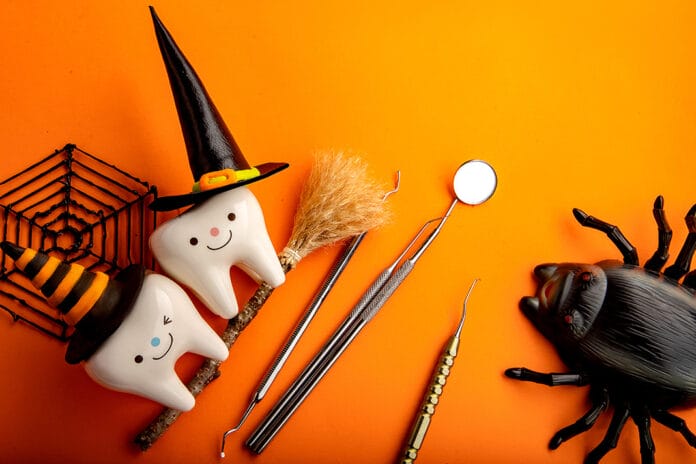‘Tis the season of football, cooler temperatures, sweaters, pumpkins, and exquisite leaf foliage. While summer is my jam, I do love the beauty and excitement the fall season brings. Let’s not forget that October is National Dental Hygiene Month. My hat goes off to each of you. October also brings a season of spooks and Halloween.
As a child, I loved dressing up. I can remember the excitement of walking the streets with my orange jack-o-lantern bucket, collecting as much candy as my mother allowed. The simplicity of collecting free candy simply by reciting “trick or treat” never ceased to amaze me. As a dental hygienist and mother, I still find the magic of this holiday but exercise more caution as I now have a more educated view of its potential harm – tooth decay.
Before we jump into the meat of this topic, let’s first refresh our facts about this spooky season.
A Quick History of the Spooky Season
Halloween was not indeed the season we all know today. It originated 2,000 years ago with the ancient Celtic festival of Samhain. Traditionally celebrated on October 31, this day marked the end of summer and the beginning of the dark, cold winter which was associated with human death.1
The Celts believed that on the night before the new year, which was celebrated on November 1, the boundary between the worlds of the living and the dead became blurred. To commemorate the event, the Druids, Celtic priests, made huge bonfires where people gathered wearing costumes and attempted to tell each other’s fortune.1
By the 9th century, the influence of religion had spread into Celtic lands, and traditions had gradually blended. In the 10th century, November 2 was deemed All Souls’ Day and was celebrated similarly to Samhain. The celebration of All Saints’ Day was also called All-Hallows or All-Hallowmas, so the traditional Celtic night of Samhain began to be called All-Hallows Eve. Eventually, it was called Halloween.1
In the 1920s and 1930s, Halloween was popularized in America on a community level.1 By the late 1940s, trick or treating was widespread on a national scale, where fruits, nuts, and coins were the popular loot. In the 1950s, candy began to make its debut during this popular festivity, and by the 1970s, it became seen as the only economically legitimate treat.2
Today, one-quarter of all the candy sold annually in the U.S. is purchased for Halloween.1 Americans spent an estimated $3.6 billion on candy in 2023.3 Like my children, the more candy a child can collect that fun-filled night, the better. The average jack-o-lantern bucket carries 250 pieces of candy that amount to 9,000 calories and three pounds of sugar!2 Are your molars hurting?
Favorite Night for Bacteria, Too
It’s no secret that candy is made with sugar, the very food source for the bacteria in your mouth. When this bacterium, Streptococcus mutans, feeds on this sugar as an energy source, it produces lactic acid as a waste that demineralizes tooth structure.
The main sugars in candy are sucrose, fructose, and glucose. In addition, acid additives such as lemon juice help crystallize certain types of candy. Oral bacteria really enjoy sucrose to create “scaffolding” to survive on the teeth and better attack the surface.4
Halloween candy increases the abundance of sugar and the frequency in which it is consumed. What many dental patients fail to realize is that length of exposure plays a large role in the destruction of tooth enamel.
Hard candy and gummies tend to stick around longer, thus increasing the risk of decay. Hard candy, such as suckers, take longer to consume, and gummies get stuck in the grooves of molars and can still be seen after brushing. Hard candy also poses a risk for fractured teeth, as many children will try to bite into the candy. Additionally, sour candy contains a higher amount of acidity, which further aids in the destruction of tooth structure.5
Smarter Candy Choices
Guiding parents and children to make smarter choices when it comes to their Halloween windfall is never a bad idea. Not all candy is created equal, and some choices may prevail over others. For example, chocolate is faster to consume and clear the mouth, which limits the exposure time, making this a better option. Dark chocolate has even less sugar, making it an even wiser choice.5
Sugar-free gum containing xylitol has multiple benefits. Xylitol helps eliminate the growth of Streptococcus mutans. Xylitol contributes to the promotion of remineralization by increasing the salivary flow and a rise in pH, as well as decreasing plaque.6 Please remember to keep xylitol away from your dog because it’s toxic to them.
Theories suggest that eating candy after meals is the best time to consume these sugary snacks. The theory hypothesizes that the mouth bacteria are unable to metabolize the sugars because they are “full” from the meal. Dinner, particularly, is closer to bedtime, meaning the sugar will have less exposure time if the child brushes their teeth before bed.4
In Closing
With all this said, eating candy in moderation and maintaining a thorough oral hygiene regimen is truly the best advice to offer. While offering alternatives and suggestions, such as choosing dark chocolate, is what we should do, we must also take in the practicality of the situation. I remember my excitement as a child on Halloween, and I see it now in my own children. Their eyes illuminate when they dump their buckets of candy, and I would be lying if I didn’t say I pilfer through it myself.
Parents simply need to limit the daily amount of candy intake and follow the protocol of after-dinner treats. If there were ever a better time to hone in on oral hygiene, now would be the time. Educating parents and children on the frequency and diligence of brushing, interdental cleaning, and routine dental appointments is essential to helping children reduce their risk of caries. This is also a great opportunity to educate on the importance of sealants and fluoride.
I feel that we should not take away the joy of this fun holiday but instead help parents understand the magnitude of what it can create if appropriate measures aren’t taken. While some dentists are buying candy from their patients, I feel education is far more valuable and helps create responsibility.
I hope this knowledge didn’t spook you, but it’s important to remember that Halloween candy can come back to haunt us if we allow it.
Before you leave, check out the Today’s RDH self-study CE courses. All courses are peer-reviewed and non-sponsored to focus solely on high-quality education. Click here now.
Listen to the Today’s RDH Dental Hygiene Podcast Below:
References
- Halloween 2024. (2024, October 3). History. https://www.history.com/topics/halloween/history-of-halloween
- Kawash, S. (2010, October 21). How Candy and Halloween Became Best Friends. The Atlantic. https://www.theatlantic.com/health/archive/2010/10/how-candy-and-halloween-became-best-friends/64895/
- Consumer Spending on Halloween Candy in the United States From 2017 to 2023. (2024, January 16). Statista. https://www.statista.com/statistics/1305961/halloween-candy-spending-us/
- Schulman, G., Katechia, B. (2019, October 24). Dentists: Halloween Candy May Come Back to Haunt You. UConn Today. https://today.uconn.edu/2019/10/dentists-halloween-candy-may-come-back-haunt/
- McKeon, A. (2021, October 29). Cavities Are No Trick: How to Balance Halloween Candy With Healthy Teeth. Boston Children’s Hospital. https://answers.childrenshospital.org/cavities-are-no-trick-how-to-balance-halloween-candy-with-healthy-teeth/
- Nayak, P.A., Nayak, U.A., Khandelwal, V. The Effect of Xylitol on Dental Caries and Oral Flora. Clinical, Cosmetic and Investigational Dentistry. 2014; 6: 89-94. https://www.ncbi.nlm.nih.gov/pmc/articles/PMC4232036/











